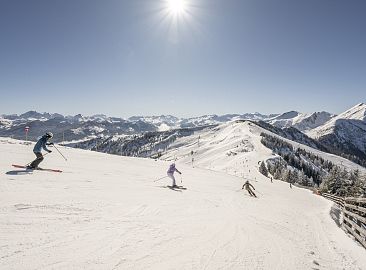Current avalanche conditions
in Salzburger Land
Please be very mindful of the current avalanche conditions in Salzburg province, as well as the present situation in alpine terrain. A fundamental truth: every avalanche, and even a small slab of snow, poses a threat to life and limb for those who are buried or struck. Often, the areas where avalanches originate may look harmless, especially to the untrained eye. Unfortunately, the destructive force of avalanches and slabs of snow is frequently underestimated.
Make it your top priority to prevent such accidents. By triggering an avalanche, you put your own life, and potentially the lives of others at risk!
By the way: On pistes that are open for skiing, your avalanche safety is guaranteed!
If you do want to enjoy the powder snow - whether as an off-piste skier, freerider, snowboarder, ski tourer, or snowshoer - there are some basic rules that must be observed.
Tips for increased off-piste safety
- Heed avalanche threat levels
- Plan your tours with avalanche and weather reports in mind
- Never (even if the avalanche threat level is low) venture into open terrain without proper equipment (avalanche transceiver, shovel, probe, fully charged mobile phone). This applies to every group member. Everyone should have practiced with their own equipment at least once.
- Check avalanche transceivers before each tour to ensure they are functioning.
- Maintain spacing on the steep slopes, keeping a 10-meter distance between individual ski mountaineers during the ascent.
- Always ski the steep slopes one at a time; with an incline under 35 degrees, maintain at least 30-meter separation.
- At threat level 3 or above, only ski on slopes with less than a 35-degrees incline.
Behavior in an actual avalanche
- If several people are above the avalanche, one must take charge of coordinating the response.
- Make an emergency phone call immediately (140 mountain rescue, 144 ambulance, or 112 international emergency). If no mobile phone or reception is available, one group member should ski down to the valley and make the emergency call.
- Begin with a general search - see if you can spot anything anywhere at all.
- Switch all available avalanche transceivers to search mode, otherwise, you'll interfere with each other.
- Search the avalanche cone from the bottom up, preferably without skis. If you are alone above the avalanche, make wide loops—from 15 meters on one edge to 15 meters before the opposite edge, then 30 meters up and back in the opposite direction. If you have several search devices, approach the cone uphill spaced 30 meters apart.
- Follow any signal received and "cross out" the other beeps, which means: Where the signal is loudest or the distance the least, draw a line in the snow. Along this line, also search in another, intersecting direction. The loudest point will then be where the transceiver you are searching for is located.
- Dig with all your might! Skis and snowboards are utterly unsuitable tools for digging; they only waste precious energy.
- Ideally, a helicopter with a doctor will already be on the spot, otherwise, perform resuscitation on the buried individual if necessary.
Behavior below the avalanche
- Only a few skiers manage to escape the danger zone by reacting quickly and skiing away quickly. Early awareness of an avalanche while skiing is essential. Simply standing still often leads to the person being buried. Equally essential: excellent skiing skills, confident movement under stress, and at high speeds.
- If you fall and have little time: Get out of the bindings, release straps, discard ski poles. Fight against the avalanche! Resist being pulled down.
- When you feel the avalanche slowing down, put your hands in front of your face. Try to create a free space for your mouth and an air pocket.
- Conserve your strength. If you can't break through the snow layer on the first attempt, don't waste energy on further futile attempts which would consume valuable oxygen.
- Stay calm - at all costs.
- Shout if a rescuer is directly above you, with all the strength you’ve got.

In the first 35 minutes, the victim is fighting for survival against suffocation (assuming there are no life-threatening injuries from the fall). After that, the danger of hypothermia begins. If you are rescued after this point, you must be treated with extreme care. Cold blood must not mix with the core blood from the brain, heart, lungs, and abdomen. Excessive movement can lead to a life-threatening condition even in the hospital.








